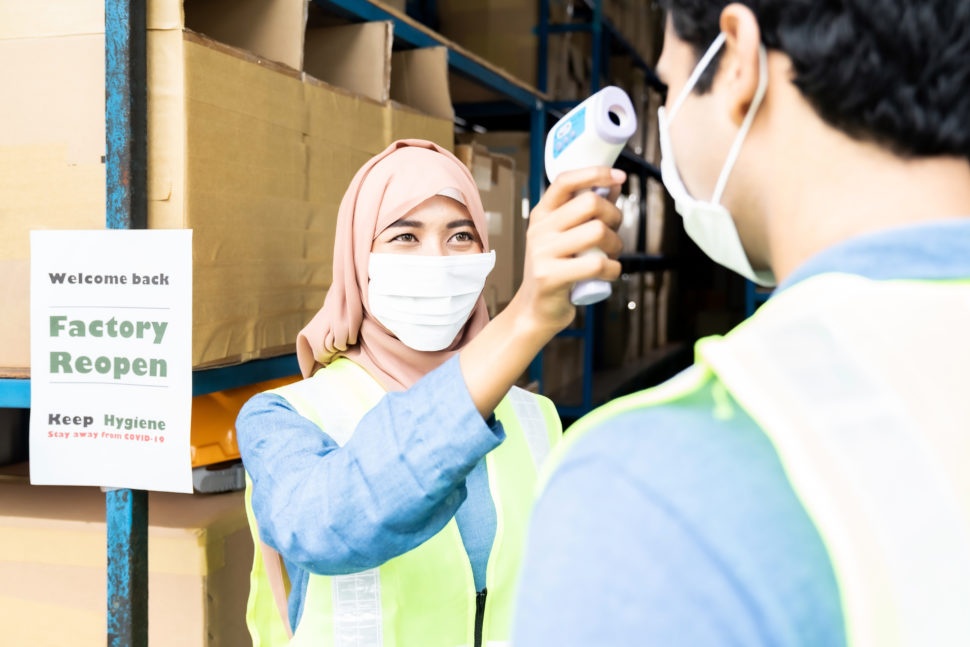In the early months of any new year, safety professionals look ahead and make plans for their upcoming workplace safety programs. In 2021, we expect to see employee training as an even bigger focus than usual.
Throughout the United States, employers are still working through the multiphase process of reopening following the outbreak of the COVID-19 pandemic. While many employees may have not yet fully returned to work, such as those in personal care or bars and restaurants, industries such as manufacturing and construction must continue.
Employers will need to take into consideration not only their typical training procedures but also new safety protocols to keep up with what the experts will be requiring and what the public — your employees — will likely want to see to feel safe.
Start with the Basics
Setting up a workplace safety program can seem intimidating, but it doesn’t have to be. Here are some basic recommendations that any organization can use to help you focus your safety-planning energies.
- Conduct a job hazard analysis (JHA) to identify and work to correct potential dangers in your specific workplace
- Ensure safety starts at the top because workplace safety is more likely to occur when education and implementation start with the leadership
- Train all workers on general safety topics as well as site- and job-specific challenges, which can be identified during a JHA
- Conduct regular inspections both to make sure workers are doing their jobs correctly but also to identify changes that could be made
- Make reporting easy and free of retaliation so all incidents or near misses can be recorded through the proper channels
- Seek input from workers while making changes to the workplace and make it known any safety suggestions are welcome at any time
- Hold regular toolbox talks to cover important, relevant safety information, that does not need a full training session, in a timely manner

Of course, it is expected for safety programs to look a little different this year, as companies must now also take additional precautions into consideration, but these tips can serve as a simple starting point for any new, or improved, program.
Safety Protocols are More Than Just Physical
Creating an effective work environment moving forward is going to require more than just the normal safety precautions. With millions of people across the country continuing to be affected by COVID-19, employers will need to take a look at the ways many jobs are done within their organization.
Here are a few different categories of things to review:
- Physical considerations include distancing individual workspaces, supplying personal protective equipment, ensuring proper airflow throughout any indoor areas, and creating restrictions in common areas.
- Process considerations include allowing for working in shifts, making it easy for employees to self-screen and report any symptoms, reviewing how shipping and/or receiving is handled, and providing regular communication to all employees.
- Psychological considerations include offering mental health and wellness programs, providing ways for employees to manage workplace stress, and reviewing or implementing your Employee Assistance Program (EAP).
These have been stressful, unsure times for everyone, and employers need to make sure they take care of their employees, or at least make it easy for the employees to take care of themselves.
Above All, Follow Official Guidance
No matter what adjustments your workplace decides to continue or to begin implementing, it can be helpful to review the guidelines put in place by those in charge of our health and safety: OSHA and the CDC.
OSHA provides an in-depth guide for all employers that outlines, among other things, basic steps that can be followed to help reduce the risk of exposure to COVID-19. At a high level, OSHA suggests:
- Creating an infectious disease response plan
- Preparing basic infection prevention measures
- Implementing procedures for how to proceed if an employee gets sick
- Developing, and communicating, workplace flexibilities
- Enforcing workplace controls
- Following existing applicable standards

Following recommended guidelines from health experts, the CDC offers similar suggestions as OSHA but does also include some additional information, such as tips specifically for working inside office buildings, which carries broad application.
The CDC can also be a helpful resource for employees, especially as more and more people return to work. Of course, they continue to recommend wearing a mask in public and practicing social distancing when possible, but they also provide a list of questions for employees, or employers, to ask themselves before heading into the workplace.
- Do you have or think you might have COVID-19, or have you been around someone who has the virus?
- Are you or someone in your household at increased risk of severe illness?
- Are you the primary caregiver for your child or someone else?
- Are there ways you can minimize the number of people you interact with?
- What’s the length of time that you will be interacting with people?
With extreme variance of COVID-19 infection rate across the United States, it is important for everyone to be aware of the common symptoms of the virus. You should also make sure you encourage your employees to report the first signs of any symptoms to their supervisor so that proper precautions can be taken.
How Online Training Can Help
Now that you probably have a better idea of things you need to consider when reviewing your safety program, you will need to determine the best way to make sure your entire staff is trained throughout the year.
Looking for more online safety training content?
Over the last several years, online training has become more commonplace, and it will likely see an even greater use now with the widespread implementation of working from home and with social distancing becoming the new norm. Remote training can help your workforce get caught up on regulatory training requirements or maybe even learn new skills.

One benefit of online training is how easy it is to utilize microlearning, which is the concept of breaking down typical training topics into short, bite-sized modules. These short bursts of content — often less than 10 minutes — mean your employees would not need to commit a large portion of their day to training.
Additionally, while all personal protective equipment (PPE) should be tried on and tested before being used in the field, online training makes it easy to introduce, or reintroduce, all of your employees to different types of PPE. Utilizing online training for PPE allows employees to become more comfortable with equipment they may encounter on the job.
As is the case with any training, repeating safety training at regular intervals could help employees stay up-to-date with regulations and further reinforce knowledge. Online training makes it easy to assign and complete refresher training as often as is needed or as often as you’d like. While some regulations require training to be conducted at least annually, it is never a bad idea to brush up on safety training even when not required.
Choosing the Right Training
The last step in reviewing and finalizing your safety program plans is to find a training partner that delivers what you want. Here are a few features you may want to look for when selecting a provider that will help make your 2021 safety program a success.
Engaging, up-to-date content
To be effective, any training content must be able to keep the learner’s attention. Illustrating interesting visuals, implementing user-friendly navigation, offering multiple language options and utilizing relatable scenarios can help keep the training content fun and engaging, meaning increased retention.
While training courses need to be engaging, they would of course be worthless if the content is out of date. Make sure any training content you decide to use is regularly reviewed and updated by the creators to be consistent not only with industry trends but, more importantly, with changing requirements and regulations.
Safe group training
Even before the COVID-19 pandemic required social distancing measures, many trainers were moving away from the large-group, in-person training model. And now, the ability to offer virtual training is even more indispensable.
Whether your organization prefers Zoom, Microsoft Teams, GoToMeeting or some other platform, utilizing a virtual “conference call” can make it easy to train certain segments of your team at one time.
Maintain accurate reporting
No matter the size of your workforce, it can be quite a task maintaining up-to-date training records for everyone. Built-in tracking and reporting can make it easy to know, in an instant, where your team stands in the training process throughout the year.
Look for a system that allows you to create learning groups, assign individual or group training, run completion reports, send automatic course reminders, and save full training reports for audits and inspections.
As we head into a new year, it is the ideal time to evaluate your current safety program to protect your employees. For more than 20 years, SafetySkills has made occupational health and safety training easy, no matter your industry, job title or location. Contact SafetySkills today to see how we can help you get started on improving your safety program.


